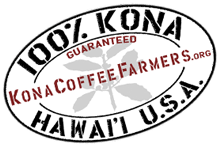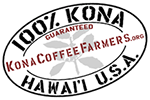The KCFA is NOT against blending. Blending is a roaster’s art to produce just the flavor his customer wants. What the KCFA DOES object to is LABELING of a 90% foreign coffee in a bag as a “Kona blend”. It is inherently deceptive to use the “Kona” name for 90% foreign-grown coffee. It is a matter of common sense.
“Kona blend” DOES NOT mean a blend of Kona grown coffees gathered from various coffee farms in Kona. “Kona blend,” means the package of coffee you purchase needs legally to contain only 10% Kona coffee. A close search of the package label is needed to find the valuation of “not less that 10% Kona coffee”. While buyers may wonder what kind of coffee constitutes the other 90% of the blend, this information is not required to be listed. “Kona blend” is not the same as 100% Kona coffee. Blenders want to use the Kona name because it is regarded as one of the world’s best coffees. In most cases, the added inferior coffee beans have been imported specifically to be mixed at a 9 to 1 ratio with the Kona coffee beans. 90% of the coffee in the bag has been fumigated with chemicals. By law, imported coffee beans must be fumigated with methyl bromide, a pesticide and a toxic material.
The Environmental Protection Agency (EPA) is aiming to phase out the use of methyl bromide. Kona coffee beans do not get fumigated. A roasted Kona Blend coffee sells for as much as 100% or more than roasted foreign coffees from Brazil, Indonesia, Africa and Central America, yet contains only 10% Kona. Even a quality Colombian at specialty coffee shops is often $9 a pound. Kona blends on line and in airports are often $18/lb or more. This means compared to 100% Kona Coffee, the profit margin on a Kona blend lures marketers away from quality to achieve profits. Don’t be fooled into buying a “Kona blend”. If you like your Kona coffee blended, buy 100% Kona and 100% of another quality coffee and do the blend yourself until you get what you prefer.
KCFA Legislative attempts to increase the amount of real Kona Coffee in a Kona Blend, from 10%, have been ongoing via the Hawaii State Legislature.
Legislation has been proposed by the KCFA to:
- AMEND HRS 486-120.6 to provide that the word “Kona” may not be used on any coffee package label as a brand name or otherwise, including in connection with any “Kona coffee blend”, unless at least 75% of the coffee by weight was grown in Kona.
- FURTHER AMEND 486-120.6 to provide that on the packaging of any “Kona coffee blend” the geographic origin and percentage by weight of any United States grown coffee and the country of origin and percentage by weight of any foreign-grown coffee must be prominently identified.
Reasoning:
Based on the Napa Wine regulation (Cal. Bus. & Prof. Code, Section 25241 (“Napa Truth-in-Labeling Law”); substantiating that 75% Napa wine must be used in order to carry the “Napa” name and which was taken to the Supreme Court and allowed to stand, the KCFA proposed the same requirement for Kona Blends.
Consequences:
In April 2007 the Hawaii State Legislature made a factual determination that “existing labeling requirements for Kona coffee causes consumer fraud and confusion and degrades the ‘Kona coffee’ name.” (SCR102/SD1/HD1).”
The current state of affairs is that a study has been authorized, by the State Legislature on the market appeal of “Kona Blends” to see if it would be detrimental to Kona Farmers. The KCFA sees this as a mere “stall” tactic and certainly not valuable. It is being used to avoid dealing with on-going Consumer Fraud. If there is to be a study, the focus should be on the extent to which the current status quo damages Kona coffee growers economically and degrades the Kona coffee name. For example, given basic principles of supply and demand, to what extent does the estimated annual sale in Hawaii of 5 million pounds of “fake Kona coffee” (i.e., 10% Kona blends) swamp the approximately 3.5 million pounds of coffee grown in Kona each year, depress prices for the genuine article, and lower the income of Kona coffee farmers? What is the cost of the status quo to coffee growers?
We know of no other region anywhere in the world that permits the use of the names of its specialty crops with as little as 10% genuine content. Have you ever seen:
- A 10% Blend of Scotch Whiskey?
- A bag of 10% Idaho Potatoes?
- A 10% Bag of Maui Onions?
- A 10% Napa Wine?
The question is “Why is Hawaii law out-of-step? Why is Hawaii permitting damage to the Kona name, instead of protecting one of the State’s heritage crops?”
Reputation Damage
e.g. Consumer Reports, December 2004 edition, the writers confused “Kona coffee blends” with “Kona coffee” and concluded that Kona coffee can be “second rate” on the basis of a mistaken belief that “Kona blends” are “Kona coffee”. ongoing…

